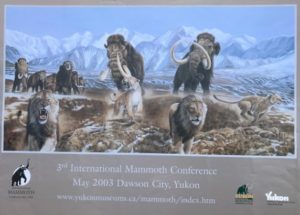Pleistocene Park: A Large Scale Restoration, Part I
Much of the far north landscape of the world is covered with tundra. In some areas the main vegetation is a blanket of mosses and lichens. In others it is shrubs and spindly trees called tiaga. And mixed in with both types are grasses, sedges, and forbs. The caribou can survive on the former, the moose can pick out little willow and birch from the latter, and the muskox can pick its way through, eating a bit of everything. No other large herbivores can make a decent living on this fare.
However, geologists and archeologists recognize that deeper back in time, vast areas had predominantly grass cover, which supported mammoths, mastodons, bison, camels, horses, musk oxen, moose, caribou, etc., plus their many predators like the dire wolf, the short-faced bear, and the sabretooth cat. This was especially the case in Siberia, which had a vast grassland “steppe” ecosystem.
Near the end of the last glaciation, these grasslands mostly faded away, converting to dominantly moss and lichen, or shrub and tree, and most of the large herbivores disappeared with it. The popular assumption was that some sort of climatic shift, maybe dryer and warmer, had caused this change.
However, a third of a century ago, a young Russian researcher named Sergey Zimov said this story is backward; that the big animals managed the grasslands, and when they were killed off by us humans, the grasses had no one to fertilize them, or work their seeds into the soil, or break up the ever encroaching moss, lichen, and shrub layers, or uproot the scruffy shading trees. He also claimed that the animal-inhabited grasslands deepened the permafrost and kept it from thawing, especially by constantly trampling the winter snow and making it a poor insulator. This is important today because worldwide the north-country permafrost contains vast amounts of carbon in various mobile chemistries, and if it gets released too fast it can set up a feedback loop of rising temperatures, which will speed up the thaw.
In 1988, Russia granted Sergey 40,000 acres in one of the most remote locations in central Siberia, plus some funding. His goal was to gradually convert it to a “Pleistocene Park,” populated by cold-hardy northern herbivores, ideally the original species from the last Ice Age, or their closest relatives. And underlying this goal is the assumption that the vegetation will convert back to a steppe grassland.

Our former “mammoth steppe” in the Yukon, during the last Ice Age, as portrayed by an artist, and inspired by the geologic record. And yes, we had African-type lions in the cold far north.
He began by upgrading his on-site research station to have a year-round place to live and work from. Then, building some large pens, some measured in square miles, he imported European moose, Canadian bison (the wood buffalo), reindeer (caribou) from Finland, and horses from Siberian Yakut hunters.
Just as he got underway, Russia reorganized itself, which you and I most readily recall as the Berlin Wall coming down. But Sergey could foresee the socio-economic consequences coming, with supplies getting scarce and the ruble devalued. So he way overspent and pre-spent his budget on basic supplies like fence posts, chain link fence, fuel, forage for the animals and food. And with his extreme isolation from Moscow, he managed to stay under the radar.
So he continued adding a select breed of Tibetan yak, musk oxen, and European elk. And now his son Nakita was old enough to help. The last I heard, they had enclosed multiple species together, testing for compatibility and whether there is any teamwork amongst them nudging the ecosystem quicker toward grassland.
But progress was slow, in part simply because of few animals on a vast acreage. However, hundreds of miles away was an abandoned army base, where he managed to scrounge a derelict tank, get it running, and drive it home. With it, he deliberately used the treads to tear up additional acres, with and without animals, and to crush trees, and become sort of the equivalent of a herd of elephants working through a young Asian forest, or a herd of mammoth in a scrubby northern forest. Interviewers laugh when he says that his big regret for this simulation is that “tanks don’t poop.” But he is not joking, as rapid recycling is an integral part of his future ecosystem.
As this back-to-the-Pleistocene history approaches 2019, it continues to become more amazing. Stay tuned next week for Part II.


